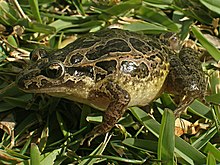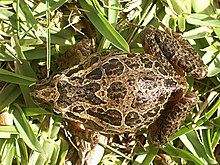Actual disc tongues
| Actual disc tongues | ||||||||||||
|---|---|---|---|---|---|---|---|---|---|---|---|---|

Corsican disc beater ( Discoglossus montalentii ) |
||||||||||||
| Systematics | ||||||||||||
|
||||||||||||
| Scientific name | ||||||||||||
| Discoglossus | ||||||||||||
| Otth , 1837 |
The real discolet ( Discoglossus ) are a genus within the family of the Alytidae and are mainly found in countries and on islands in the western Mediterranean region of Europe and north-west Africa. In addition, Israel and possibly Syria used to belong to the area of distribution. These amphibians have relatively smooth and colorful skin and can be found near and in bodies of water. These "lower" frogs differ from the real frogs , among other things, in their vertically oval pupil and the arrangement of the palatal teeth , which are located behind - not between - the inner nostrils. In addition, their tongue is disc-shaped and almost completely fused with the floor of the oral cavity. In addition to the German, the scientific generic name Discoglossus , which translated means "disc tongue", indicates this. The eardrum is often not clearly visible from the outside.
species
The genus currently comprises 6 species:
- Discoglossus galganoi Capula, Nascetti, Lanza, Bullini & Crespo , 1985 - Iberian disc beater
- Discoglossus jeanneae Busack , 1986 - Cädiz-Scheibenzüngler
- Discoglossus montalentii Lanza, Nascetti, Capula & Bullini , 1984 - Corsican disc beater
- Discoglossus pictus Otth , 1837 - Painted Scheibenzüngler
- Discoglossus sardus Tschudi in Otth , 1837 - Sardinian disc beater
- Discoglossus scovazzi Camerano , 1878 - Moroccan disc beater
The Moroccan disc beater was treated as a subspecies of the painted disc beater until recently. The biological systematics of the genus Discoglossus on the Iberian Peninsula also underwent a fundamental re-evaluation at the end of the 20th century.
The Israeli disc beater was transferred to the genus Latonia within the family of Alytidae in 2012 .
Species protection
All species are protected under the Bern Convention ; as European amphibians are also subject to the Federal Species Protection Ordinance as "particularly protected". Furthermore, they are all listed in Appendix IV of the Habitats Directive (“species to be strictly protected”). With the exception of D. pictus , all actual disc flippers are also listed in Appendix II. This means that suitable protected areas must be set up for such occurrences.
Distribution of Discoglossus galganoi
Distribution of Discoglossus montalentii
Distribution of Discoglossus pictus
Distribution of Discoglossus sardus





